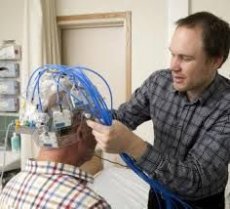Medical expert of the article
New publications
A helmet with microwaves will help in timely diagnosis of the type of stroke
Last reviewed: 02.07.2025

All iLive content is medically reviewed or fact checked to ensure as much factual accuracy as possible.
We have strict sourcing guidelines and only link to reputable media sites, academic research institutions and, whenever possible, medically peer reviewed studies. Note that the numbers in parentheses ([1], [2], etc.) are clickable links to these studies.
If you feel that any of our content is inaccurate, out-of-date, or otherwise questionable, please select it and press Ctrl + Enter.

A special helmet-shaped device used to examine brain tissue will help specialists determine the type of stroke in the shortest possible time. Such a device is capable of diagnosing the disease early and quite effectively, which will undoubtedly affect the quality of treatment. According to statistics, stroke is currently the fourth leading cause of death in the United States.
Each year in America, more than 130,000 stroke deaths occur, with about 800,000 new cases diagnosed each year.
There are two main types of stroke:
- ischemic (or cerebral infarction) develops with acute circulatory disorder (thrombus). This type of stroke is the most common, ischemic stroke is diagnosed in 80% of cases.
- A hemorrhagic stroke occurs when an artery that supplies blood to the brain ruptures.
In both types of strokes, there is a decrease in blood supply to the brain.
The prognosis for stroke depends on the location and damage to the brain. Stroke can lead to paralysis, memory loss, speech impairment, vision impairment, and death is also common. In addition, specific treatment is carried out for each type of stroke. Usually, thrombolytic drugs are prescribed for ischemic stroke, but such treatment is contraindicated for hemorrhagic stroke.
Currently, the main problem for doctors is that it is not always possible to determine what type of stroke a patient has based on the external manifestations of the disease, and without this, it is impossible to prescribe treatment. As a rule, patients are forced to undergo a CT scan, which takes time. If acute thrombolytic treatment is started within three to four hours of the onset of a stroke, this will help to significantly reduce or even prevent the symptoms of ischemic stroke. If doctors are able to quickly diagnose the type of stroke, they will be able to quickly prescribe effective treatment, which in turn will reduce potential damage to the brain.
A research team tested a helmet that uses small microwave radiation to create a picture of the blood vessels in the brain. According to the developers, such a device will help quickly and effectively eliminate any problems with cerebral blood circulation, which will allow patients to increase their chances of recovery.
The new device was tested by specialists in hospital conditions on patients (almost 50 people took part in the testing). It is worth noting that the new technology is capable of self-learning, i.e. it learns previous experience and with each new diagnosis the helmet shows more and more accurate results.
Experts note that the new helmet cannot prevent extensive brain damage, but it will help significantly reduce the patient's time in the hospital and reduce the need for rehabilitation, which is positive not only for patients, but also for the healthcare system as a whole.


 [
[